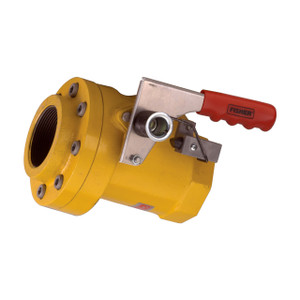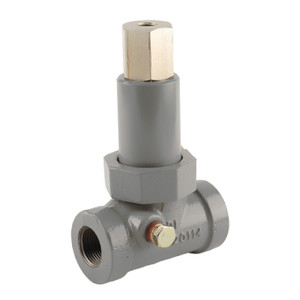Emerson Fisher Type N563 Snappy Joe™ High Flow Emergency Shutoff Valves (ESVs) are designed for railcar protection during product transfer of Propane, Butane, and other Pressurized Fluids. It is attached to the shutoff valve on railroad tank cars. Type N563's high flow reduces loading/unloading time by up to 50%. It has a 2-inch FNPT coupling allowing the user the flexibility to install the desired length of 2-inch NPT piping to fit the tank dome.
Note: Type N563 ESV is designed for higher flow needs. It flows up to 413 GPM / 1563 LPM to reduce loading/unloading time and provide faster railcar turnover.
Features
- UL Listed
- Shutoff in event of fire
- Shutoff in event of excess flow
- Remote shutoff capability
- Stainless Steel construction
- Light Weight
- Application Flexibility
- Hex couplings and ACME connections for ease of piping assembly
- Fusible Element Provides Thermal Release
Specifications
- Series: N563
- Type: Emergency Shutoff Valve (ESV)
- Inlet: 2 in. FNPT
- Outlet: 2 in. FNPT or 3 1/4 in. Male ACME
- Elastomer: Nitrile (NBR)
- Closing Flow: 413 GPM (Propane)
- Maximum Allowable Inlet Pressure: 400 psig / 27.6 bar WOG
- Temperature Range: -20° to 180°F / -29° to 82°C
- Fuse Link Melting Temperature: 212°F / 100°C
- Certifications: UL, CRN
Warning
Warning: Failure to follow these instructions or to properly install and maintain this equipment could result in an explosion and/or fire causing property damage and personal injury or death. Fisher™ equipment must be installed, operated and maintained in accordance with federal, state and local codes and Emerson Process Management Regulator Technologies, Inc. instructions. The installation must also comply with NFPA No. 58, ANSI K61.1, and DOT standards. Only personnel trained in the proper procedures, codes, standards and regulations of the applicable industries shall install and service this equipment.
Downloads
Instruction Manual (PDF Download)










